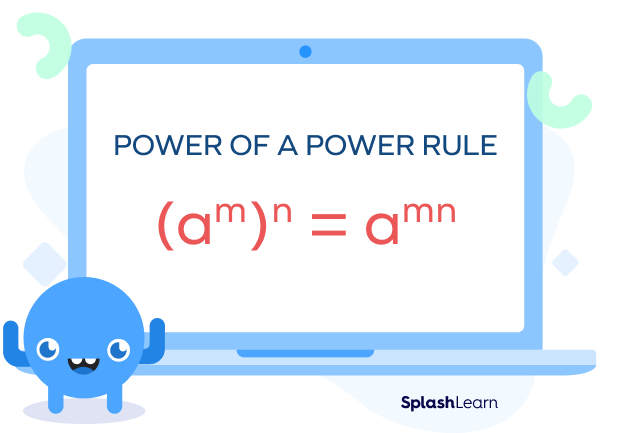What Is the Power of a Power Rule?
The power of a power rule is an important exponent rule (law of exponent) used to simplify an expression of the form $(x^{m})^{n}$, where the base x is raised to a power m and the entire expression $x^{m}$ is raised to the power n again.
Power raised to a power rule is given by
$(x^{m})^{n} = x^{m \times n} = x^{mn}$ …where x is the base, m and n are exponents
This means that if a base is raised to power and on the whole term raised to another power, then the two powers are multiplied, keeping the same base.
- $x^{m}$ means that the base “x” is multiplied by itself “m” times.
- $(x^{m})^{n}$ means that the base $(x^{m})$ is multiplied by itself “n” times.
- $x^{mn}$ means the base “x” is multiplied by itself “mn” times.

Power of a power rule examples:
- $(a^{2})^{3} = a^{2 × 3} = a^{6}$
- $(2^{4})^{2} = 2^{4 × 2} = 2^{8}$
- $\left[(p + q)^{5}\right]^{7} = (p + q)^{5 × 7} = (p + q)^{35}$
- $\left[(\;-\;1)^{4}\right]^{2} = (\;-\;1)^{4 × 2} = (-1)^{8} = 1$
Recommended Games
Power of a Power Rule with Negative Exponents
When we are dealing with the negative exponents, we have to also apply the multiplication rules used with respect to the negative sign.
Note that $x^{-\;n} = \frac{1}{x^{n}}$.
- $(a^{-\;m})^{-\;n} = a^{-\;m ×\;-\; n} = a^{mn}$
- $(a^{-\;m})^{n} = a^{-\;m × n} = a^{-\;mn} = \frac{1}{a^{mn}}$
- $(a^{m})^{-\;n} = a^{m × \;-\;n} = a^{-\;mn}$
- $(x^{-\;m})^{-\;n} = x^{-\;m ×\;-\;n} = x^{mn}$
Examples:
- $(2^{-\;2})^{-\;3} = (2)^{-\;2 × \;-\;3} = 2^{6} = 64$
- $(x^{-\;m})^{n} = x^{-\;m × n} = x^{-\;mn} = \frac{1}{x^{mn}}$
- $(2^{2})^{-\;3} = (2)^{2 × \;-\;3} = 2^{-\;6} = 164$
Recommended Worksheets
Fraction Power to Power Rule
Let’s understand the power to a power rule of exponents when the exponent is a fraction.
In this case, the two denominators and numerators are multiplied.
The formula can be written as
- $(x^{\frac{m}{n}})^{\frac{p}{q}} = x^{\frac{pm}{qn}}$
- $(x^{m})^{\frac{p}{q}} = x^{\frac{pm}{q}}$
- $(x^{\frac{m}{n}})^{p} = x^{\frac{pm}{n}}$
Let us see some examples of rational power of a power rule to understand better:
- $(x^{\frac{1}{2}})^{4} = x^{\frac{1}{2} × 4} = x^{2}$
- $(2^{\frac{3}{2}})^{\frac{2}{3}} = 2^{\frac{3}{2} × \frac{2}{3}} = 2^{1} = 2$
- $(3^{-\;2})^{\frac{3}{2}} = 3^{-\;2 × \frac{3}{2}} = 3^{-\;3} = \frac{1}{3^{3}}$
Simplifying Expressions the Power of a Power Rule
Let’s simplify an expression using the power of a power rule.
Example: Find the value of $\left[(\;-\;3)^{2}\right]^{3}$.
To simplify the expression $(\;-\;3^{2})^{3}$, we have to apply the power to the power rule, because the base is raised to a power and the whole is raised to another power. So we have to multiply the powers 2 and 3 to simplify this expression.
$\left[(\;-\;3)^{2}\right]^{3}$
$= (\;-\;3)^{2 × 3}$
$=(\;-\;3)^{6}$
$= (\;-\;3) × (\;-\;3) × (\;-\;3) × (\;-\;3) × (\;-\;3) × (\;-\;3)$
$= 729$
Facts about Power of a Power Rule
- The power of a power rule can be used if the base is raised to a power and the whole term is again raised to another power. The two powers can be multiplied without changing the base.
- Power of a power rule formula: $(a^{m})^{n} = a^{mn}$
- Any non-zero base raised to the power 0 is 1.
- Power of a power rule is also termed as power to a power rule.
Conclusion
In this article, we have learned the power of a power rule and its formula in detail. We have also understood the application of the power of a power rule in simplifying expressions with negative and rational exponents. Now let us solve and practice the rule with a few examples.
Solved Examples on Power of a Power Rule
1. Identify the value of $(5^{2})^{2}$.
Solution:
Given expression: $(5^{2})^{2}$
The power of a power formula is, $(a^{m})^{n} = a^{mn}$
Let us multiply both the powers,
$(5^{2})^{2} = 5^{2 × 2} = 5^{4}$
Now solve the expression
$5^{4} = 5 × 5 × 5 × 5$
$5^{4} = 625$
Thus the value of the expression $(5^{2})^{2}$ is 625.
2. Find the value of $\left[(\;-\;3)^{-\;3}\right]{-\;2}$.
Solution:
Given expression: $\left[(\;-\;3)^{-\;3}\right]^{-\;2}$
By using the power of a power formula, $(a^{-\;m})^{-\;n} = a^{-\;m × \;-\;n} = a^{mn}$
Let’s solve the expression.
$\left[(\;-\;3)^{-\;3}\right]^{-\;2}$
$= (\;-\;3)^{-\;3 × \;-\;2}$
$= (\;-\;3)^{6}$
$= 729$
Thus the value of the expression $\left[(\;-\;3)^{-\;3}\right]^{-\;2}$ is 729.
3. Find: $\left[(125)^{6}\right]^{\frac{1}{2}}$.
Solution:
Formula: $(x^{m})^{\frac{p}{q}} = x^{\frac{pm}{q}}$
$\left[(125)^{6}\right]^{\frac{1}{2}}$
$= (125)^{6 × \frac{1}{2}}$
$= (125)^{3}$
$= 5$
Practice Problems on the Power of a Power Rule
Power of a Power Rule: Definition, Rules, Examples, Facts, FAQs
Find the correct answer for the following: $(a^{-\;m})^{-\;n} =$?
Based on the power of a power rule for negative exponent formula,
$(a^{-\;m})^{-\;n} = a^{mn}$
Calculate the value of $\left[(\;-\;3)^{-\;2}\right]^{-\;4}$.
$\left[(\;-\;3)^{-\;2}\right]^{-\;4} = (\;-\;3)^{-\;2 × \;-\;4} = (\;-\;3)^{8}$
Simplify the following: $\;-\;3 + (5^{2})^{\frac{1}{2}}$.
$\;-\;3 + (5^{2})^{\frac{1}{2}} = \;-\;3 + 5^{1} = 2$
Frequently Asked Questions on the Power of a Power Rule
What is the fraction power to power rule?
$(x^{\frac{m}{n}})^{\frac{p}{q}} = x^{\frac{pm}{nq}}$
How to apply the power to the power formula?
If the base a is raised to a power m and the entire expression $a^{m}$ is again raised to the power n, then we keep the same base and multiply the powers $(a^{m})^{n} = a^{mn}$.
What is the product rule of exponents?
$a^{m} \times a^{n} = a^{m\timesn}$
What is the negative exponent rule and the power of a power rule in algebra?
Power of a power rule: $(a^{m})^{n} = a^{mn}$
Negative Exponent Rule: $a^{-m} = \frac{1}{a^{m}}$


































